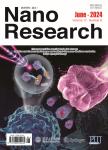DNA-directed assembly of copper nanoblocks with inbuilt fluorescent and electrochemical properties: Application in simultaneous amplification-free analysis of multiple RNA species
DNA-directed assembly of copper nanoblocks with inbuilt fluorescent and electrochemical properties: Application in simultaneous amplification-free analysis of multiple RNA species作者机构:Centre for Personalized Nanomedicine Australian Institute for Bioengineering and Nanotechnology (AIBN) The University of Queensland Brisbane Australia School of Chemistry and Molecular Biosciences The University of Queensland Brisbane Australia
出 版 物:《Nano Research》 (纳米研究(英文版))
年 卷 期:2018年第11卷第2期
页 面:940-952页
核心收录:
学科分类:0710[理学-生物学] 071010[理学-生物化学与分子生物学] 0808[工学-电气工程] 07[理学] 0809[工学-电子科学与技术(可授工学、理学学位)] 08[工学] 0805[工学-材料科学与工程(可授工学、理学学位)] 0702[理学-物理学]
基 金:supported by the UQ Postdoctoral Research Fellowship funding received by our laboratory from the National Breast Cancer Foundation of Australia support from the Australian Government Research Training Program Scholarship
主 题:prostate cancer,RNA detection,DNA templated coppernanostTuctures,amplification free,fluorescence detection,electrochemical detection
摘 要:The intrinsic affinity of DNA molecules toward metallic ions can drive the specific formation of copper nanostructures within the nucleic acid helix structure in a sequence-dependent manner. The resultant nanostructures have interesting fluorescent and electrochemical properties, which are attractive for novel biosensing applications. However, the potential of using DNA-templated nano- structures for precision disease diagnosis remains unexplored. Particularly, DNA- templated nanostructures show high potential for the universal amplification-free detection of different RNA biomarker species. Because of their low cellular levels and differing species-dependent length and sequence features, simultaneous detection of different messenger RNAs, microRNAs, and long non-coding RNAs species with a single technique is challenging. Here, we report a contemporary technique for facile in situ assembly of DNA-templated copper nanoblocks (CuNBs) on various RNA species targets after hybridization-based magnetic isolation. Our approach circumvents the typical limitations associated with amplification and labeling procedures of current RNA assays. The synthesized CuNBs enabled amplification-free fM-level RNA detection with flexible fluorescence or electrochemical readouts. Furthermore, our nanosensing technique displays potential for clinical application, as demonstrated by non-invasive analysis of three diagnostic RNA biomarkers from a cohort of 10 prostate cancer patient urinary samples with 100%-concordance (quantitative reverse transcription- polymerase chain reaction (PCR) validation). The good analytical performance and versatility of our method may be useful in both diagnostics and research fields.



